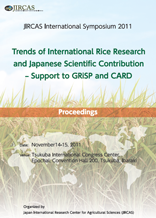Rice Genetic Diversity Platform to Accelerate Gene Discovery and Precision Breeding

Genetic diversity is the foundation of the genetic improvement of crop plants. Knowledge of multiple facets of
rice genetic diversity from the molecular to the phenotypic is essential for effective conservation and use to
meet current and future needs. Under the GRiSP research agenda, we seek to harness collective research
capacity to achieve innovations that are not possible by individual institutions alone. We envision major
innovations of significant scale and scope. These include:
? integrating management of the world’s largest collection of rice genetic resources;
? establishing a global public genetic diversity research and gene discovery platform;
? modernizing trait evaluation using high-throughput precise phenotyping;
? designing plant genotypes for climate-change scenarios;
? producing a more efficient rice plant (C4) for the future.
In this talk, I will highlight on-going work and initiatives under GRiSP that will benefit from close
collaboration with research institutions in Japan.
Closing the gene-phenotype gap with systematic genotyping and phenotyping. As a foundation for
breeding and gene discovery research, we are building a genetic diversity research platform to enable efficient
use of rice diversity. Underpinning this platform are several essential components:
? Detailed genotypic and phenotypic evaluation of a common set of genetic resources. This involves the
use of a collection 2,000 diverse rice lines in genome-wide association studies to discover gene-phenotype
relationships (Tung et al. 2010). The 2,000 lines are being genotyped by a 1 M SNP chip. By evaluating
this germplasm collection for multiple traits in different environments, we will determine the
gene-phenotype relationships, and genotype x environment interactions. In parallel, multi-traits mapping
populations are being developed to enable high resolution mapping to validate gene-phenotype
relationships predicted by association mapping. These include the Nested Association Mapping (NAM)
populations developed by CIAT and AfricaRice, and the Multi-parent Advanced Generation InterCross
(MAGIC) populations developed by IRRI.
? Decoding a significant portion of the International Rice Gene Bank (10% of accessions) to identify rare
alleles for use in breeding.
? Integrating the sequence and phenotype information to enable the design of new virtual genomes for
high-value varieties.
Precision breeding to develop climate-ready rice. Climate change is expected to significantly affect the
abiotic and biotic environments where rice is grown. Changes in temperature and availability of water in
quantity (too much or too little) and in quality (salinity) will directly impact rice productivity. Such climatic
conditions are already prevalent in regions of the world where food security is a major concern. For
developing climate-ready rice, we need to assemble a battery of stress tolerance genes and put them intoready-to-use breeding stocks. Major genes and large-effect QTL have been identified to to confer tolerance to
submergence, salinity, and drought conditions. Examples include genes for submergence tolerance (Sub1) and
salinity-tolerance (Saltol1), and major QTL for sustaining yield under drought stress. Research on heat
tolerance or avoidance is progressing, leading to identification of useful genetic variation. The study of
early-morning flowering pioneered in Japan illustrates the use of new traits for adaptation to new
environments. Due to the dynamic nature of pathogen and insect populations, it is more difficult to predict the
impact of climate change on the biotic environment. New approaches to improve resilience to the variable
pathogen and insect populations are therefore needed. Recent advances in our understanding of non-host
resistance may lead to new strategies to achieve stable resistance to multiple diseasess (Alyffe et al 2011).
Breaking the yield ceiling. A key achievement made in modern plant breeding is the dramatic change in
harvest index (HI), where the grain yield constitutes over 50% of the total biomass (HI >0.5). However,
further improvement of HI beyond 0.55 has proved difficult. To further increase grain yield, it is necessary to
explore new approaches to increase total biomass and to enhance photosynthetic and respiratory efficiency. A
GRiSP Workshop on Yield Potential was held in August 22-26, 2011 at CIAT, Colombia to discuss strategies
on raising the yield potential of rice. From this workshop, five research areas emerge as important: 1) combine
large-effect genes for yield component traits, 2) accumulate QTLs controlling yield potential traits using
Marker-Aided Recurrent Selection and Genomic Selection, 3) exploit yield enhancing loci from wild species,
4) enhance the level of heterosis, and 5) breeding for physiological traits. The identifcaiton of large-effect
QTL affecting yield components in Japan is particularly relevant to this effort.
Each of these research activities requires collaboration to bring together complementary expertise to achieve
the objectives. Leveraging rice research in Japan will be crucial to success. The International Rice Genome
Sequencing Project (IRGSP) led by Japan produced the first reference genome of rice that has impacted every
aspect of rice genetics research. The large collections of rice mutants (Tos17 lines, FOX lines) and specialized
genetic stocks (chromosomal substitution lines, near-isogenic lines) produced in Japan will continue be the
drivers of gene discovery.Many genes of potential agronomic importance have already been identified by
different laboratories in Japan. These genes can be evaluated in multiple genetic backgrounds and
environments through different GRiSP networks. GRiSP provides a mechanism to promote such collaboration
and to accelerate the translation of scientific research into practical impact.
| Date of issued | |
|---|---|
| Creator | Hei Leung |
| Subject |
climate change genome sequencing productivity stress tolerance |
| Publisher | Japan International Research Center for Agricultural Sciences |
| Available Online | |
| Issue | 2011 |
| spage | 68 |
| epage | 75 |
| Rights | Japan International Research Center for Agricultural Sciences |
| Language | eng |
